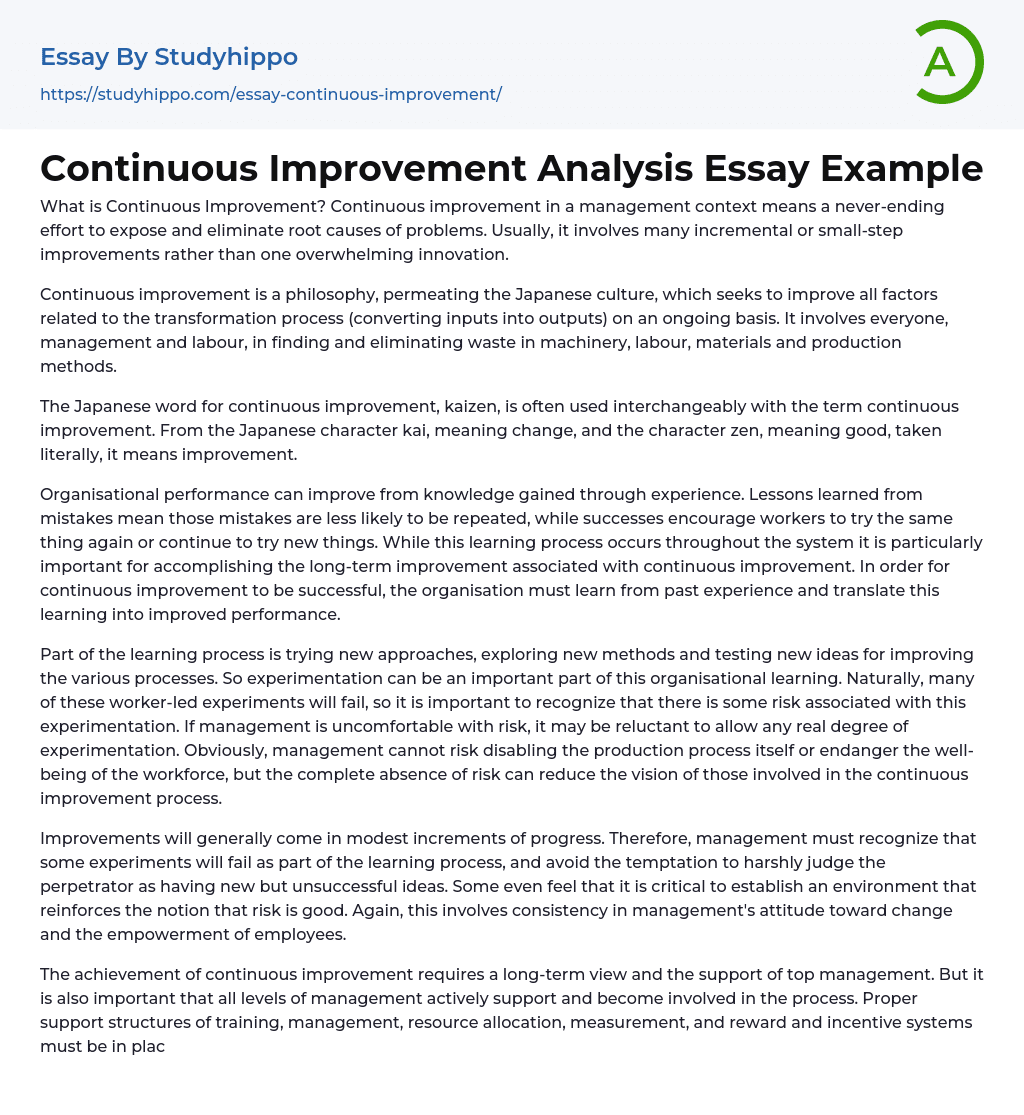What is Continuous Improvement? Continuous improvement in a management context means a never-ending effort to expose and eliminate root causes of problems. Usually, it involves many incremental or small-step improvements rather than one overwhelming innovation.
Continuous improvement is a philosophy, permeating the Japanese culture, which seeks to improve all factors related to the transformation process (converting inputs into outputs) on an ongoing basis. It involves everyone, management and labour, in finding and eliminating waste in machinery, labour, materials and production methods.
The Japanese word for continuous improvement, kaizen, is often used interchangeably with the term continuous improvement. From the Japanese character kai, meaning change, and the character zen, meaning good, taken literally, it means improvement.
Organisational performance can improve from knowledge gained
...through experience. Lessons learned from mistakes mean those mistakes are less likely to be repeated, while successes encourage workers to try the same thing again or continue to try new things. While this learning process occurs throughout the system it is particularly important for accomplishing the long-term improvement associated with continuous improvement. In order for continuous improvement to be successful, the organisation must learn from past experience and translate this learning into improved performance.
Part of the learning process is trying new approaches, exploring new methods and testing new ideas for improving the various processes. So experimentation can be an important part of this organisational learning. Naturally, many of these worker-led experiments will fail, so it is important to recognize that there is some risk associated with this experimentation. If management is uncomfortable with risk, it may be reluctant to allow any real degree of experimentation. Obviously
management cannot risk disabling the production process itself or endanger the well-being of the workforce, but the complete absence of risk can reduce the vision of those involved in the continuous improvement process.
Improvements will generally come in modest increments of progress. Therefore, management must recognize that some experiments will fail as part of the learning process, and avoid the temptation to harshly judge the perpetrator as having new but unsuccessful ideas. Some even feel that it is critical to establish an environment that reinforces the notion that risk is good. Again, this involves consistency in management's attitude toward change and the empowerment of employees.
The achievement of continuous improvement requires a long-term view and the support of top management. But it is also important that all levels of management actively support and become involved in the process. Proper support structures of training, management, resource allocation, measurement, and reward and incentive systems must be in place for successful adoption. This includes a willingness to provide financial support and to recognize achievements. It is desirable to formulate goals with the workers' help, publicise the goals, and document the accomplishments. These goals give the workers something tangible to strive for, with the recognition helping to maintain worker interest and morale.
Continuous Improvement also requires that all employees in the organisation be involved in the process. Every employee must be motivated to accept continuous improvement as a means by which the firm can achieve a competitive advantage in the marketplace. All involved must push continuously at the margins of their expertise, trying to be better than before in every area.
Through continuous improvement, firms
are able to produce better products and services at lower prices, thus providing greater customer satisfaction. In the long term, the final product will be more reliable, of better quality, more advanced, cheaper and more attractive to customers.
Why Implement Continuous Improvement? Because implementing the Continuous Improvement Philosophy across people & processes breeds organisational success.
If facilitated in the correct manner, Continuous Improvement will result in: * Significantly improved teamwork & enhanced communication at every organisational level * Increased efficiency and process improvement
* A much stronger bottom line.
In addition, successful action plans as a result of Continuous Improvement will greatly assist leaders of organizations in achieving strategic initiatives and developing trainable and measurable operational processes.
Continuous improvement begins with properly identifying a problem or non-conformance and then fixing it. This process also addresses the nature of the problem and the environment within which the problem exists, and then changes the environment to ensure that the problem doesn't recur. Each step builds and improves on the former; each level covers more aspects than just the original identified problem and has a wider, more telling effect on the organization.
Today's management systems provide a way for management to make something happen. Continuous improvement in quality, environmental, health or safety is part of this formula and the backbone of how change occurs.
All managerial activity is either directed at control or improvement. Managers are either devoting their efforts at maintaining performance, preventing change or creating change, breakthrough or improvement. If businesses stand still they will lose their competitive edge, so improvements must be made to keep pace and stay
in business.
- Accident essays
- Awareness essays
- Benefits of Volunteering essays
- Challenges essays
- Childhood Memories essays
- Decision essays
- Driving essays
- Event essays
- Excellence essays
- Expectations essays
- Failure essays
- Farewell essays
- Flight essays
- Gift essays
- Growing Up essays
- Ignorance essays
- Improve essays
- Incident essays
- Knowledge essays
- Luck essays
- Memories essays
- Mistake essays
- Obstacles essays
- Overcoming Challenges essays
- Party essays
- Peace Corps essays
- Personal Experience essays
- Problems essays
- Sacrifices essays
- Struggle essays
- Success essays
- Trust essays
- Vacation essays
- Visit essays
- Volunteering essays
- Incentive essays
- Attitude essays
- Goals essays
- Personal Goals essays
- Personal Life essays
- Personality essays
- Principles essays
- Reputation essays
- Self Awareness essays
- Self Esteem essays
- Self Reflection essays
- Self Reliance essays
- Strengths essays
- Value essays
- Values essays




